5 Easy Lead Conversion Tips For Your Email Marketing Program
 Besides social media, email marketing is the first thing that I tell anyone to do when it comes to online marketing. To succeed online, you absolutely must be using email effectively. The evidence doesn't lie.
In a 2012 survey conducted by McKinsey & Company, they found that for e-commerce companies "e-mail remains a significantly more effective way to acquire customers than social media—nearly 40 times that of Facebook and Twitter combined."
Woah!
Besides social media, email marketing is the first thing that I tell anyone to do when it comes to online marketing. To succeed online, you absolutely must be using email effectively. The evidence doesn't lie.
In a 2012 survey conducted by McKinsey & Company, they found that for e-commerce companies "e-mail remains a significantly more effective way to acquire customers than social media—nearly 40 times that of Facebook and Twitter combined."
Woah!
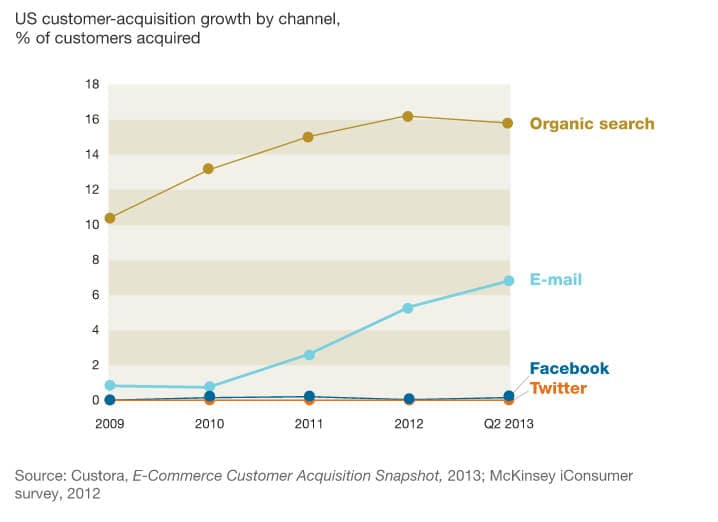 E-mail is still a significantly more effective way to acquire customers than social media.
While you may not be running an e-commerce company yourself, the implications seem to be well accepted across the industry. Social media scientist Dan Zarrella of Hubspot came to a similar conclusion in research that he completed in 2012. Email converts well, and is a key part of the customer acquisition process.
E-mail is still a significantly more effective way to acquire customers than social media.
While you may not be running an e-commerce company yourself, the implications seem to be well accepted across the industry. Social media scientist Dan Zarrella of Hubspot came to a similar conclusion in research that he completed in 2012. Email converts well, and is a key part of the customer acquisition process.
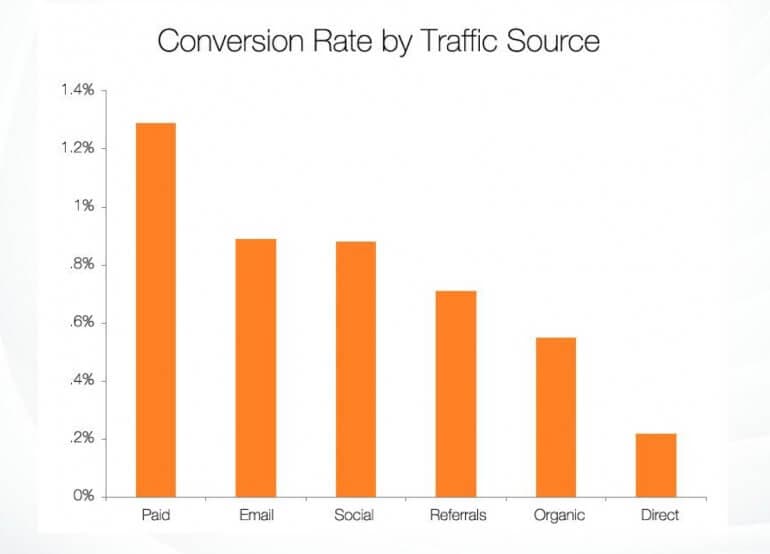 Conversion rate scores as compiled by Hubspot.
If you're not using email marketing, you could be missing out on huge potential for your company or blog. More than that, if you aren't using email to convert readers into paying customers – YOU ARE DOING IT WRONG.
You might be leaving sales on the table!
Here at CoSchedule, we have nearly 20,000 email subscribers that continually bring in new customers to our service. We like to think about it as a slow and steady drip. We keep sending out great content, and our readers keep coming to us for help with their scheduling and social media needs. It's a great fit, and one that works because our email marketing is focused on building trust with our audience.
So, how can you create an email program that converts for your own brand or business? It's actually not that hard if you are focused on the right things. Here are the top 5 ways that you can embrace email and turn your email marketing program into a lead conversion machine.
Conversion rate scores as compiled by Hubspot.
If you're not using email marketing, you could be missing out on huge potential for your company or blog. More than that, if you aren't using email to convert readers into paying customers – YOU ARE DOING IT WRONG.
You might be leaving sales on the table!
Here at CoSchedule, we have nearly 20,000 email subscribers that continually bring in new customers to our service. We like to think about it as a slow and steady drip. We keep sending out great content, and our readers keep coming to us for help with their scheduling and social media needs. It's a great fit, and one that works because our email marketing is focused on building trust with our audience.
So, how can you create an email program that converts for your own brand or business? It's actually not that hard if you are focused on the right things. Here are the top 5 ways that you can embrace email and turn your email marketing program into a lead conversion machine.
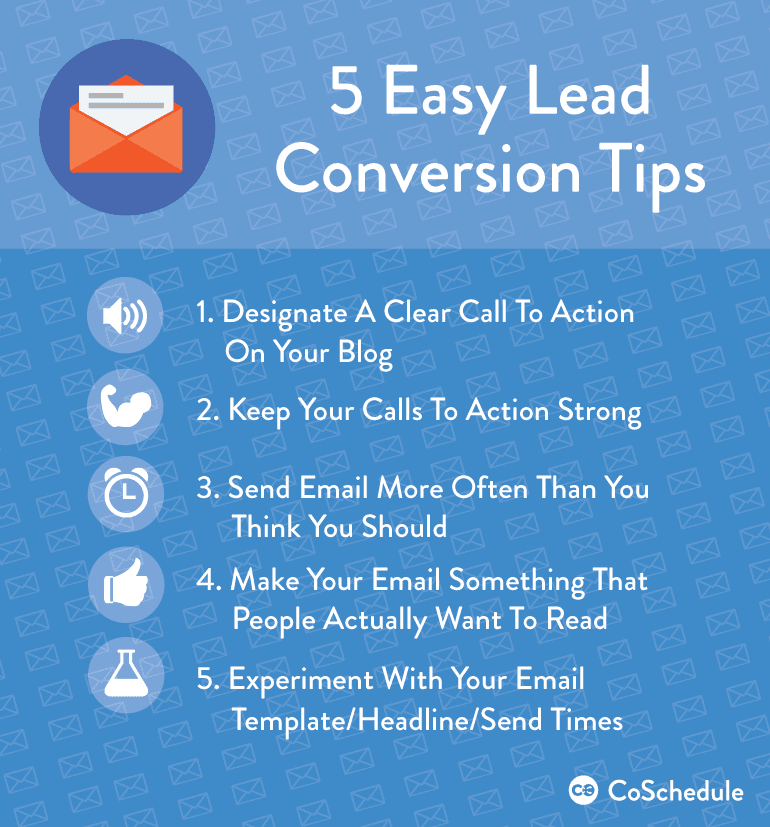
Here's How To Turn Your Email Marketing Into A Lead Conversion Machine
Click To Tweet#1. Designate A Clear Call To Action On Your Blog
The first lesson about creating an effective email marketing program is getting good at collecting email addresses. There are many ways to go about this, and several plugins that you can start using right now to jump start your lead collection process, but the point is that you need to be making a concentrated effort on collecting emails or else your marketing list will never actually materialize.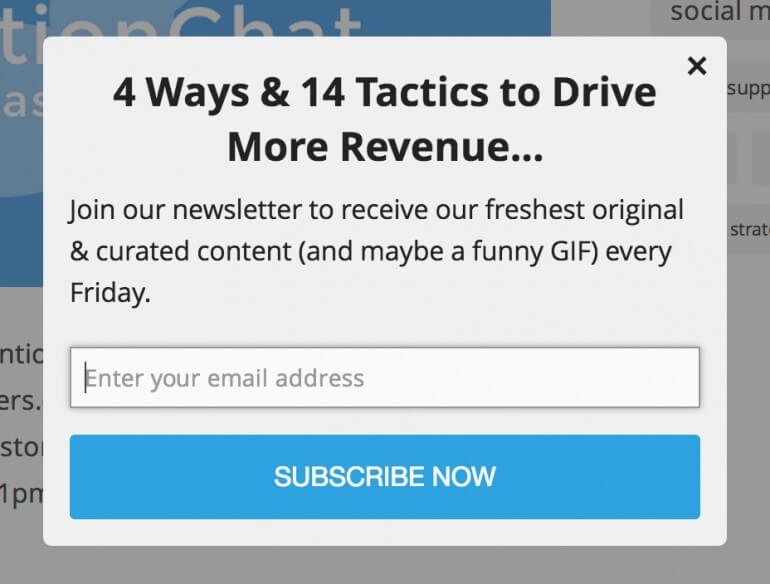 Mention.com offers a great call to action when you visit their blog.
It is also important to make sure that your blog is properly configured to drive visitors to the lead collection option. This means reducing you sidebar clutter, and continuously driving your reader to a lead collection form. This is about creating a simpler blog layout.
Mention.com offers a great call to action when you visit their blog.
It is also important to make sure that your blog is properly configured to drive visitors to the lead collection option. This means reducing you sidebar clutter, and continuously driving your reader to a lead collection form. This is about creating a simpler blog layout.
Email marketing is 40 times more effective at acquiring customers than social media.
Click To Tweet--
#2. Keep Your Calls To Action Strong
If you've ever worked in sales, you've heard the phrase "always be closing." While it may be tacky, it certainly isn't wrong. Not only do you need to be creating opportunities for your customers to convert (by including lead collection points), but you also need to be positioning your copy in a way that specifically asks them to subscribe.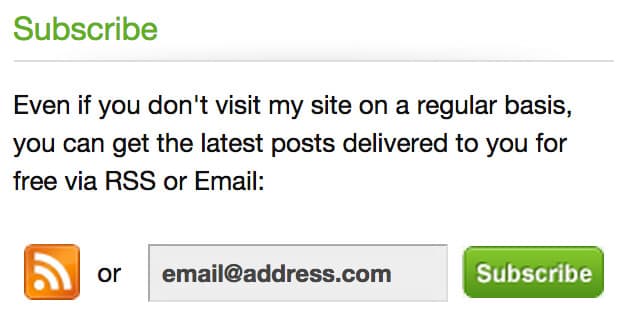 While it technically does it's job, it's not quite a call to action.
I can't tell you how many times I've seen a bland call to action like this one above. I'm sorry folks, but "please join my email list" just isn't going to do it for many people. What's in it for them? Why should they? Take a look at a few examples of people doing it right. What do you see?
While it technically does it's job, it's not quite a call to action.
I can't tell you how many times I've seen a bland call to action like this one above. I'm sorry folks, but "please join my email list" just isn't going to do it for many people. What's in it for them? Why should they? Take a look at a few examples of people doing it right. What do you see?


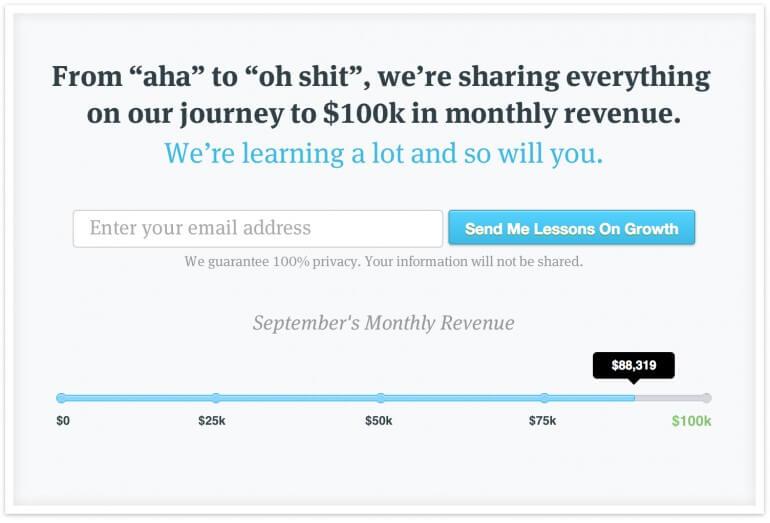
- They all identify a clear benefit that the reader will receive when they subscribe.
- They all offer a clear command or directive such as "subscribe now." This isn't a suggestion, it is a command.
- Many of them offer the reader social proof and provide good reasons for them to consider subscribing or at least taking the offer seriously.
--
#3. Send Email More Often Than You Think You Should
Many marketers and bloggers like yourself instinctively shutter at the idea of sending more email, but you can probably send a whole lot more than you think. In a recent study, Hubspot found that there was essentially no correlation between both unsubscribes and click-through rates and the frequency of email being sent.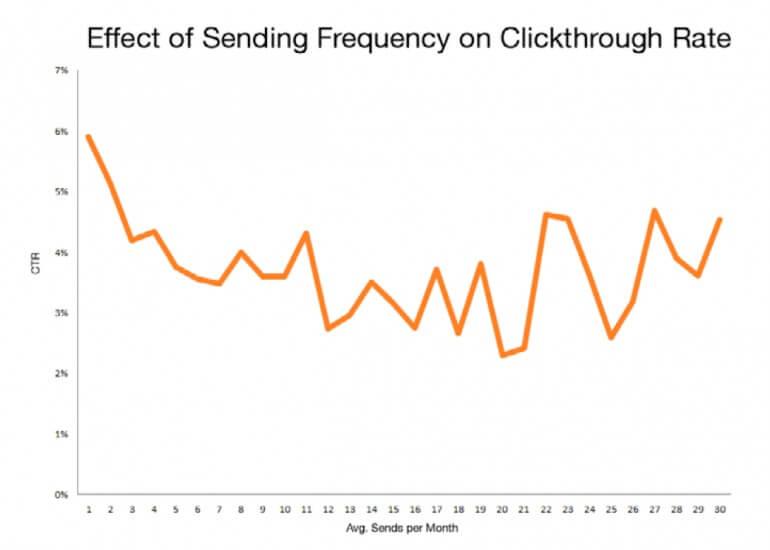 There is almost no correlation between send frequency and click through rates.
There is almost no correlation between send frequency and click through rates.
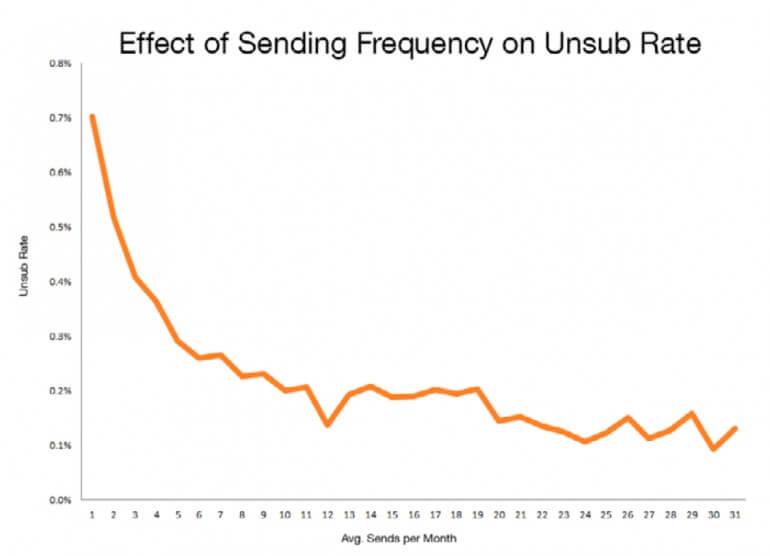 There is little correlation between the number of times you send your email and the number of unsubscribes you will receive.
What they actually found was that if your email list is willing to put up with 5-10 emails per month, they are probably just as likely to put up with 15 or 20.
From Hubspot:
There is little correlation between the number of times you send your email and the number of unsubscribes you will receive.
What they actually found was that if your email list is willing to put up with 5-10 emails per month, they are probably just as likely to put up with 15 or 20.
From Hubspot:
The more emails that were sent to the lists in my dataset, the fewer people unsubscribed. This is probably because if you’re sending very infrequently, it can be easy to forget why I joined your list in the first place, but if you’re sending regularly, I remember your newsletter.
--
#4. Make Your Email Something That People Actually Want To Read
Never underestimate the importance of reader value. Everything that you do in marketing should offer your readers value. I like to think of it in terms of what you are trading them for their time. What you are giving your readers in exchange for their time spent with your marketing. Social media consultant Jay Baer describes it another way as "marketing so good that they would be willing to pay for it."Shoot for [Email] Marketing so good that your readers would be willing to pay for it! #Content @jaybaer
Click To Tweet We always try to pack our emails with helpful information that our readers will appreciate.
This is why at CoSchedule, we brand our email marketing around the theme of our "Content Marketing Update." This weekly email includes helpful content from our blog and some of the best articles around the web. It is usually chock full of great tips and almost always worth the time and the price for admission.
We always try to pack our emails with helpful information that our readers will appreciate.
This is why at CoSchedule, we brand our email marketing around the theme of our "Content Marketing Update." This weekly email includes helpful content from our blog and some of the best articles around the web. It is usually chock full of great tips and almost always worth the time and the price for admission.
--
#5. Experiment With Your Email Template/Headline/Send Times
One great way to continually improve your email marketing is to continually experiment with how and when you are sending it. At CoSchedule, there are a few ways that we do this.A/B Test Your Subject Lines
Honesty, this one is so easy that you should be doing it with every email that you send. Each time we send an email here at CoSchedule, we make sure to test our subject line using the automated A/B testing tool built into our email software (Campaign Monitor). This tool allows us to "pre-send" our email to a few hundred people with a couple different subject line options. Once a clear winner is found (and there almost always is one), our email tool will send the winning subject line to remaining portion of our list.
After doing this for months, we were even able to pullout some key data points and define some email subject line best practices.
This tool allows us to "pre-send" our email to a few hundred people with a couple different subject line options. Once a clear winner is found (and there almost always is one), our email tool will send the winning subject line to remaining portion of our list.
After doing this for months, we were even able to pullout some key data points and define some email subject line best practices.
Try A New Design (Or None At All)
Another great way to improve your email marketing is to continually adjust your email template. Using the A/B testing tool build into Campaign Monitor and many other email marketing programs, you should be able to easily evaluate the effectiveness of one template over another. Many companies (including CoSchedule itself) have found that sometimes email is best sent without a design template at all. Each week we send thousands of emails using a variety of well-designed email templates and plain text versions. The results usually show us that plain-text emails (or emails that look like plain text) constantly drive higher click-through rates than those with more design. Of course, results may vary. Take this with a grain of salt, and always test your own results.Experiment With Different Send Times
In his slide deck "The Science of Email Marketing" social media scientist Dan Zarrella dug up a ton of fascinating data about when to send email. For example, he found that email click-through rates tended to be almost twice as high on Saturdays and Sundays – a slap in the face to the traditional idea that marketing only takes place on weekdays.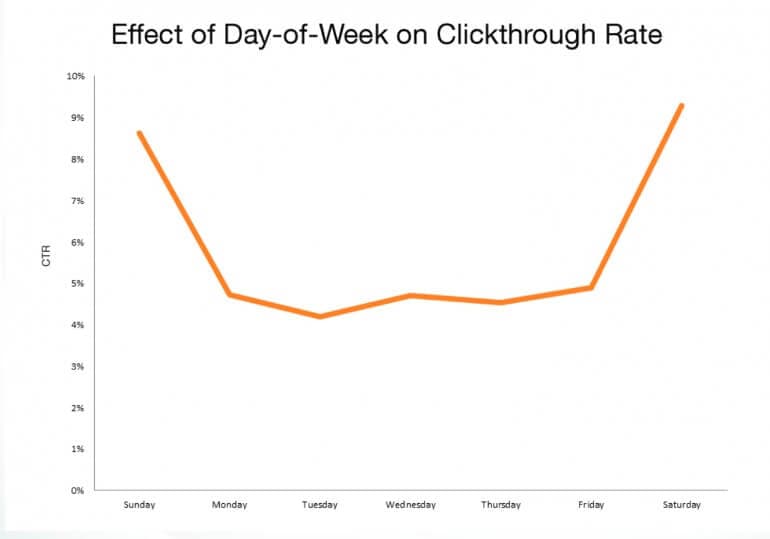 Email sent on Saturday and Sunday get more clicks.
He also found that emails sent earlier in the morning tended to get more clicks as well. The results may not apply to everyone, but it is very good food for thought.
Email sent on Saturday and Sunday get more clicks.
He also found that emails sent earlier in the morning tended to get more clicks as well. The results may not apply to everyone, but it is very good food for thought.
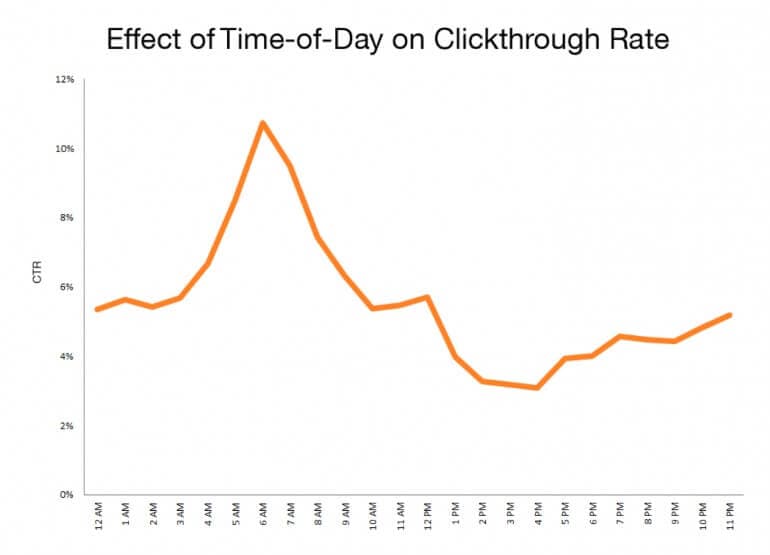 6a.m. just might be the best time to send an email if you want someone to actually read it.
The point here is that you should never be satisfied with the status-quo, even if it is yours. Always be testing your marketing so that you can get the best results.
6a.m. just might be the best time to send an email if you want someone to actually read it.
The point here is that you should never be satisfied with the status-quo, even if it is yours. Always be testing your marketing so that you can get the best results.
You should never be satisfied with the status-quo, even if it is yours. #ContentMarketing
Click To Tweet--


